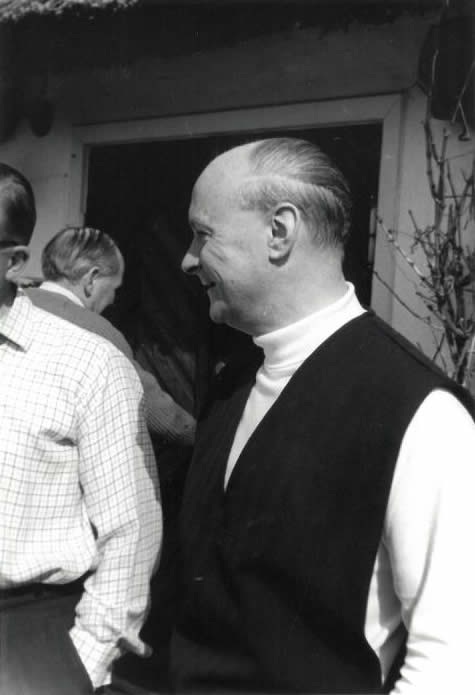Professor Charles Calnan (1917-2012)
ICDRG 1967-1988
 Charles Dermot Calnan will not only be remembered as one of the founding fathers of modern contact dermatitis, but also as one of the great dermatologists of the 20th century.
Charles Dermot Calnan will not only be remembered as one of the founding fathers of modern contact dermatitis, but also as one of the great dermatologists of the 20th century.
He had practised dermatology in Lahore during World War II and after training with Robert Klaber and David Williams, he was appointed Consultant Dermatologist at the Royal Free Hospital. One of his great mentors was Geoffrey Dowling. In 1960 he became the first Professor of Dermatology of London University and St John’s Institute of Dermatology.
In 1953 with Dr Bob Meira, he set up the St John’s Contact Dermatitis clinic, loosely based on his observations of clinical practice at the Finsen Institute of Copenhagen. The clinic has evolved into the world renowned clinic we know today. Under his tutorship, such famous contact dermatitis specialists such as Etain Cronin, Richard Rycroft, Ian White and Chris Lovell learnt their trade. A prominent founding member of the ICDRG, he started the Contact Dermatitis Newsletter which evolved into the journal Contact Dermatitis, which became the leading European journal for Contact Dermatitis publications. He also became editor of the Transactions of St John’s Hospital for Diseases of the Skin, which developed a world-wide readership.
Charles was behind the evolution of St John’s into an international centre for dermatology in the mid to late 21st century, helping create a powerful team of world-renowned dermatologists. The qualification, Diploma in Dermatology, also flourished, bringing in young dermatologists from across the globe. People schooled under Charles went on to develop their own dynamic centres. For example, Sam Shuster went onto establish Newcastle’s well-recognised dermatology centre. He championed the cause of women in dermatology, promoting such eminent individuals as Etain Cronin, Yvonne Clayton and Elisabeth Ryan.
Whilst it would have been tempting to bask in the role of an internationally famous dermatologist, Charles was active in helping the advancement of dermatology in countries such as Nigeria and Iran, often sending his best registrars. In this way he mirrored one of the founding ideals of the ICDRG. He was instrumental in assisting with the foundation of the Institute of Dermatology in Bangkok, which has gone onto flourish and which has, quite fittingly, recently seen its first representative, Dr Pailin Puangpet, appointed to the ICDRG. Despite his exceptional common courtesy, Charles was never afraid to speak his mind. At a world congress meeting where national heads of dermatology were asked to speak about the future of dermatology Charles announced in a very short speech (2 sentences) that they were all doing a terrible job and that world dermatology needed much better leadership!
Despite all his achievements in general dermatology, contact dermatitis was Charles’ dearest ‘professional’ love. Apparently, he was always happiest when meeting his ICDRG colleagues and discussing contact dermatitis cases or visiting a factory on a problem-solving mission.
Memorable publications
Suspender dermatitis and nickel sensitivity. Calnan CD, Wells GC. Br Med J. 1956 Jun 2;1(4978):1265-8
Charles gives a clinical description down to minute detail (something of a lost art). He depicts the concept of local and secondary spread, a feature of allergic contact dermatitis to nickel which is now often overlooked.
Studies in contact dermatitis. IX. Shoe dermatitis. Calnan CD, Sarkany I. Trans St Johns Hosp Dermatol Soc. 1959;43:8-26.
Charles again gives a very detailed description of allergic contact dermatitis to shoes, describing the various different patterns. The only consistent finding is a lack of involvement of the interdigital spaces.
Cyanoacrylate dermatitis. Calnan CD. Contact Dermatitis. 1979 May;5(3):165-7
Charles at his intuitive best. He diagnoses a factory outbreak of airborne irritant contact dermatitis to cyanoacrylate. He then found the relative humidity in the factory to be low. Surmising that vaporised water is likely to facilitate polymerisation of airborne cyanoacrylate and remove the risk of irritation, he instructs on the installation of humidifiers , resulting in resolution of the problem. Perhaps the humidifiers helped with some low humidity dermatitis as well, but Charles, ever the pragmatist, had cured the problem.
Prosser White Oration 1977. Dermatology and industry. Calnan CD. Clin Exp Dermatol. 1978 Mar;3(1):1-16.
A classic paper and still in some ways relevant to today. Charles knew how to finish a paper with a flourish.
“The present Contact Dermatitis Clinic at St John’s Hospital was started in one small room on I April, 1953, by Dr Meara and myself when we were senior registrars. I can well remember how we submitted our plans to the Medical Committee and asked permission to start the clinic. The day after the meeting, I was told that the Committee required more time to consider the matter and that we were not to start the clinic without their approval. As on so many other occasions I sought advice from Dr Dowling the same evening in the Imperial (a public house). His answer was simple, as always: Get on with it!”
John McFadden
